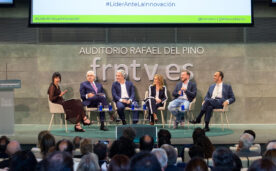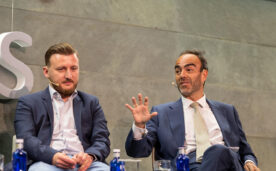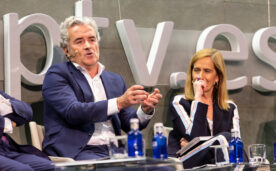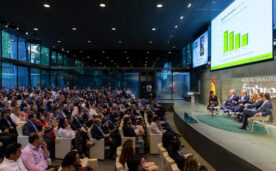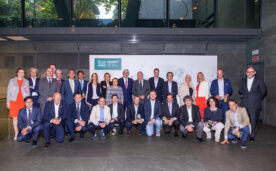Tommaso Canonici and Antonio Núñez
Summary:
On the occasion of the publication of the book "El líder ante la innovación" by Tommaso Canonici and Antonio Núñez, on 5 June 2018, a dialogue on "El líder ante la innovación" took place at the Rafael del Pino Foundation, with the participation of José D. Bogas Gálvez, CEO of Endesa; Iñaki Ereño, CEO of Sanitas; Marieta Jiménez, CEO of Merck Spain; Tommaso Canonici, founding partner and CEO of Opinno Europe and Antonio Núñez, partner and CEO of Parangon Partners. Antonio Núñez explained that the book he co-authored is a book for senior managers and their teams who really want to innovate. It is not a book of theory, but a personal book for those who want to create innovative organisations. The book is the distillation of conversations with over a hundred CEOs, with whom he discusses the keys to innovation and the barriers and obstacles that arise along the way. Tommaso Canonici, the other co-author, explained that the decisions that companies make today about innovation will affect companies much more than they realise. To explain the true extent of these decisions, he gave the example of the Space Shuttle engines. In all versions of the rocket, it is the only thing that has always been the same, because they are manufactured in Utah and have to be transported to Cape Canaveral. Transport is by train and the rockets cannot exceed the dimensions of the tunnels they have to pass through en route. The width of the tunnels is determined by the width of the tracks, which are the width of a Roman road, which was determined by the distance needed for two horses to walk together. So something as far back in time as Roman roads determine the size of the Space Shuttle engines. Canonici then presented 5+1 tips, taken from the book, which he considered very important for the innovative leader. The first is that the CEO as sole decision-maker is ineffective and dangerous. When it comes to innovation, the power to distribute decision-making leads to the amygdala effect, which can block the person in situations of uncertainty. Second tip: as far as possible, the leader should inspire an entrepreneurial attitude in the organisation. It doesn't matter what your business model is, because it will have an expiry date. We need intrapreneurs to provide the ideas to continue to survive. Third tip: innovation has to be part of the agenda of the chairman and the board. When capital is scarce, investing in efficiency generates 6% more value, but investing in innovation generates five times more value. The problem is that most boards did their MBA when capital was expensive and the focus was on efficiency. Now you have to understand that things have changed. Fourth piece of advice: in this new reality, new things keep appearing. Common sense will allow the CEO to filter out what is worthwhile and what is not. It is not about incorporating the latest technology, but about changing everything that comes after it, most of the time people. Corporate cultures are not static, but evolve over time and can be changed. To change an organisation we need people who want to change, know how to change and can change, which means teaching people to innovate. Fifth tip: to innovate is to understand the changing needs of customers. The DNA of the innovative company is to be able to anticipate trends, to think about its customers, to be agile and for everyone in the company to innovate. Last piece of advice: to change and innovate you need to get people excited. The CEO's role is to inspire others, but he is the only one who has a global perspective. He also needs his teams. To conclude his vision of what an innovative leader is, Canonici brought up a quote from an Italian immigrant in the United States: "I left for America thinking that the roads were going to be gold, but when I got there they were not gold, nor were there any roads. They were waiting for me to build them. Antonio Núñez indicated that the first important key to innovation is the involvement of the leader. Among his qualities, the first is to have a strategic vision of innovation. Secondly, there is the ability to innovate and move the entire organisation. No less important are the values: the leader's exemplarity is what legitimises him or her. In addition, he or she must be a flexible person, with a capacity for change and resilience. And he or she must know how to communicate. The board must supervise the executive team. There are questions such as the business model to have, which are the partners, the appropriate capabilities, the mix of products and services to put on the market. Hence the importance of incorporating innovative profiles on boards, so that the board is diverse. Marieta Jiménez, when you are a 350-year-old company like Merk, a process of constant innovation is written in your DNA. The fundamental challenge is to be able to constantly reinvent yourself in order to have a successful model. The principle is to create a purpose, which has to clearly define the vision, where we are going, including what it brings to the user, and to transcend the value of the business to deliver something to the society in which it lives. Innovation has to be real and effective on a day-to-day basis. Otherwise, it is not possible to change behaviour and culture. For Iñaki Ereño, the main challenge is to move from words to deeds. The CEO's main task is to act on the management chain. If nothing changes there, nothing will happen. The strategy has changed, we have to look at it in two ways, in six months and in ten years. The objectives have to be those of the digital transformation. Organisational changes have to be made, for example, having a digital transformation committee. If the incentives don't change, this is not going to happen. For his part, José D. Bogas explained that the electricity sector is going through an exciting time, with great challenges and great opportunities. In addition to the digital transformation, there is the energy transition. The factories with which they are producing have an expiry date and they have to be changed. Accepting that change is the most important thing. In 2015 they introduced the values they believed people working at Endesa should have. These values were four: innovation, proactivity, responsibility and trust. They serve as a hook for the cultural change in which innovation is sought, adapting technology to the conditions that are needed. The challenge is to be able to internalise this. To attract the best innovative talent, Iñaki Ereño recommended having inclusive projects. This means involving everyone in the company in the digital transformation and this involves listening to the customer, working with data and working across the board. Antonio Núñez reminded the audience that there is also a lot of internal talent in companies, which is why he advised defending internal promotion. In order to support the team from within, it is necessary to know how to assess whether it has the skills required for the new challenges and then attract the talent that is lacking. José D. Bogas added that we should not divide the workforce into winners and losers, but insist that we all go together. You have to have a strong training programme and offer it to people. The other big issue is that you have to manage with the best people in each area. You have to be inclusive, you have to be motivating, you have to feel involved. We have to adjust in exchange for a viable and sustainable company and a very interesting project. Marieta Jiménez clarified that innovation is not only digital transformation. It is a tool that helps us in a process that we have to go through as a company in order to remain competitive. Being CEO of a digital company is a piece of cake. The difficult thing is to transform a company that has a traditional model, how are you going to be able to attract talent, seduce the talent you have, when four different generations are coexisting in companies. Digitalisation is not only a question of efficiency, but also of sustainability. Iñaki Ereño emphasised the importance of the leader's involvement and that a fundamental part of his task is to simplify the messages so that people feel safe during the transformation process. Marieta Jiménez insisted that everything starts with vision or purpose. If it doesn't, there is nothing behind it. It is what then allows the story to be told. Culture and people are accelerating levers. The involvement of leaders is the basics. José D. Bogas, the important thing is flexibility. As things change so much, you have to know where you are going, but you also have to be able to adapt to the changes that are constantly occurring. You have to value the short term as much as the long term. You need a leader who believes in it, who steps out of his or her comfort zone. For Tommaso Canonici, what is important is the involvement of leaders to create psychological safety zones, in which people feel comfortable to fail. It must be understood that it is a long change, with many curves and many failures. Antonio Núñez, finally, would focus on the involvement of the chief executive. The CEO Superman no longer exists. He needs to be supported by good teams. Without that, there is no innovation. They should be people with values, in addition to their technical competence.
The Rafael del Pino Foundation is not responsible for the comments, opinions or statements made by the people who participate in its activities and which are expressed as a result of their inalienable right to freedom of expression and under their sole responsibility. The contents included in the summary of this conference are the result of the debates held at the meeting held for this purpose at the Foundation and are the responsibility of their authors.
The Rafael del Pino Foundation is not responsible for any comments, opinions or statements made by third parties. In this respect, the FRP is not obliged to monitor the views expressed by such third parties who participate in its activities and which are expressed as a result of their inalienable right to freedom of expression and under their own responsibility. The contents included in the summary of this conference are the result of the discussions that took place during the conference organised for this purpose at the Foundation and are the sole responsibility of its authors.

